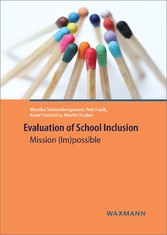Suchen und Finden
Service
Book Cover
1
Imprint
4
Table of Contents
5
Introduction – Who is this Book for and why do we need it?
7
1. Foundations – Why do we need Inclusion?
9
1.1 Philosophical and Ethical Perspectives Monika Tannenbergerová
9
1.2 Historical and Pedagogical Perspectives
15
1.3 Human Rights Perspectives
20
1.4 Economic Perspectives
26
2. Terminology – What is Inclusion?
28
3. Indicators – How Can I Recognize an Inclusive School?
34
A Thematic Dimension: Culture
35
B Thematic Dimension: Conditions
39
C Thematic Dimension: Practice
42
D Thematic Dimension: Relationships
46
4. Inclusive Education in the Czech Republic: A Literature Review and Analysis
51
Introduction Martin Vrubel & Karel Pan?ocha
51
Method
51
Overview of Selected Studies 2007–2010
53
Studies Focusing on Teachers
55
Studies Focusing on Children and Students
59
Studies Focusing on Pupils’ Parents
60
Studies with other Objectives
60
Overview of Selected Studies 2011–2015
61
Studies Focusing on Teachers
62
Research Studies Focusing on School Principals
63
Studies Focusing on Children and Students
63
Studies Focusing on Pupils’ Parents
65
Discussion
65
Conclusion
67
5. Tool for Evaluation of Inclusion at Schools
68
5.1 Creation, Form and Testing of the Tool Monika Tannenbergerová & Petr Fu?ík
68
5.1.1 Introduction to the Creation of the Tool
68
5.1.2 The Creation of the Tool
70
5.1.3 The Actual Tool and its Content (Quantitative Part)
73
5.1.4 Tool Investigation Findings (from a Sample of 23 Elementary Schools)
84
5.1.4.1 Questionnaires for Teachers
85
5.1.4.2 Standardized Interviews with School Management andObservations
91
5.1.5 Tool Quality Testing
94
5.1.5.1 Internal Consistence of Items in Questionnaire for Teachers
94
5.1.5.2 The Values of Scales for Dimensions (Aggregated Data)
101
5.1.5.3 Consistency of Indexes (Aggregated Data)
104
5.1.6 Intermediate Conclusion and Ideas for Further Work with the Tool
106
5.2 Implementation of the Tool at Schools Monika Tannenbergerová
107
5.2.1 Application of the Tool at Schools – A Recommended Procedure
107
5.2.2 Case A: Feedback for the School as a Possible Outcome of Tool Application
110
5.2.3 Case B: Feedback for the School as a Possible Outcome of Tool Application
117
5.2.4 Utilization of the Qualitative Part of the Tool and Self-assessment
124
5.2.4.1 Tool for Evaluation of Inclusion at Schools – A Qualitative Part
124
5.2.4.2 Self-assessment of schools in inclusion
134
Conclusion
156
Bibliography
157
Authors
162
Alle Preise verstehen sich inklusive der gesetzlichen MwSt.









